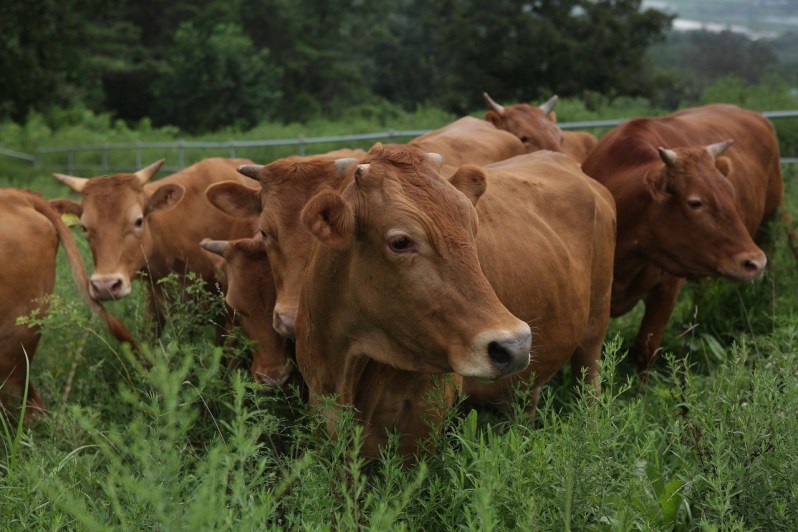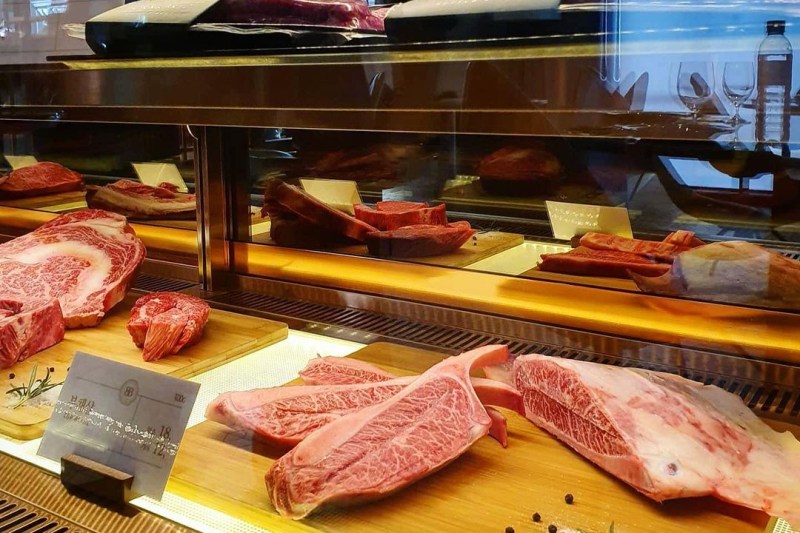
In South Korea, there’s a native breed of cattle that connoisseurs say rivals the best Japanese Wagyu beef. Known as Hanwoo, this beef is one of the most prized items in Korean cuisine and enjoyed either for celebratory dinners or given as luxurious gifts during Lunar New Year or Chuseok (Korean Thanksgiving).
What is Hanwoo beef?

Although often described as the Wagyu of Korea, the reality is that the Hanwoo breed predates all Japanese cattle. Cows first arrived in Japan from the Asian mainland over 2,000 years ago, with many of these first-generation cattle hailing from the Korean peninsula. Between 1868 and 1910, Korean genetics were also infused into cattle raised in the Japanese prefectures of Kumamoto and Kochi. In fact, Red Wagyu/Akasuhi cattle bear a strong physical resemblance to the Hanwoo breed.
Historically, beef consumption was rare in Korea since cows were primarily used as farm animals. The Hanwoo breed was originally used exclusively as a draught animal and not for meat. Hanwoo is one of the four native breeds of Korean cattle. The other three breeds are: Jeju Heugu (Jeju black cattle), Chikso (Korean brindle cattle), and Heugu (Korean black cattle).
Currently, the best Hanwoo cattle is raised in Hoengseong in Gangwon-do Province of Korea. Here, local farmers sometimes employ creative methods to ensure the best quality beef. Some farmers mix their feed with pine leaf enzyme (believed to heighten meat quality). Others keep a radio on in the cattle pens. The constant ambient noise of a human voice is believed to ease the cattle’s exposure to people, ensuring the Hanwoo will stay calm and not tense their muscles during transportation or butchering. Each Hanwoo cow also has its own electronic ID, containing information of the animal’s shots and treatment history.
South Korea has its own meat grading system. Based on a combination of marbling and color, beef is judged on the scale of 1++, 1+, 1, 2 or 3 (1++ is the highest). Another grade is the measure of “percentage of meat available for use.” This grade is separated into A, B or C. In Hanwoo terms, 1+++ is the Korean equivalent of A5 Wagyu.
Preparing Hanwoo beef

The flavor of Hanwoo can best be described as a combination of Wagyu and American Angus. Unlike Wagyu, which has a predominance of marbling, Hanwoo has comparatively less fat but an increase in beefy flavor. For many beef lovers, Hanwoo is the best of both worlds.
Hanwoo beef can be prepared Korean or Western style. Because of its combination of marbling and flavor, some Hanwoo cuts are best used for Korean barbecue. This comes down to a question of butchering, which can be quite different depending on cultures. In America, beef is usually butchered into 22 distinct cuts. But in Korea, beef can be butchered into up to 120 cuts. Two examples are top blade/flat iron (buchaesal) and plate/skirt (upjinsal), which are very popular cuts in Korea for barbecue. Both cuts reside near the organs and will possess an intensely beefy flavor.
Hanwoo can also be served butchered into steak cuts and cooked in all manner of ways. Popular steak cuts like ribeye or strip steak on the Hanwoo cattle will feature noticeably more marbling than prime American beef. This changes the flavor profile of familiar cuts. For example, steak lovers will often deride the tenderloin as bland. Because Hanwoo has so much natural beef flavor, Hanwoo tenderloin will have a heightened beefiness usually only found in more flavorful cuts.
The future of Hanwoo

Currently, Hanwoo beef is unavailable in America and only exported in limited qualities abroad. It is also relatively unknown compared to the more famous Wagyu. This is changing as some Hanwoo promotors in Korea have started to evangelize their native Korean beef to a wider audience.
One example is Jung Sang-won, the owner of Born and Bred, a unique Hanwoo restaurant in Seoul. The son of a beef seller at Majang-dong, a famous meat market and restaurant area in Seoul, Jung has created a multi-story temple to Hanwoo beef. The first floor of Born and Bred is a butcher counter, displaying various cuts of high-end Hanwoo. On the second floor is the main restaurant, but it’s the basement that features the restaurant’s crown jewel — an elegant dining room featuring a beef-tasting course modeled after the finest sushi omakase in Japan. Here, various Hanwoo cuts are cooked Korean and Western style in front of diners.
How can you get Hanwoo beef in the U.S.?
Even though Hanwoo beef isn’t readily available in the U.S., there are some ways you might be able to get your hands on it, such as through online retailers, as there are a few that specialize in selling Hanwoo beef directly to consumers in the U.S. You can search for “Hanwoo beef online retailer” to find these. Also, some high-end butcher shops, particularly those in major cities, may carry Hanwoo beef. If you live near a Korean grocery store, you might find it there.
If you can find Hanwoo beef in any way, be prepared for a hefty price tag. Hanwoo beef is considered a luxury product, so expect to pay more than you would for other cuts of beef. Also, since Hanwoo comes from Korea, it’s often shipped frozen. This doesn’t necessarily affect the quality, but it’s something to be aware of.
Hanwoo is expensive, relatively unknown, and almost impossible to find outside Korea. But this is slowly changing. Recently, Hanwoo beef has been exported to Hong Kong. It has also appeared in international pop culture hits, demonstrated by the beef’s appearance in the 2020 Oscar Best Picture winner Parasite.



